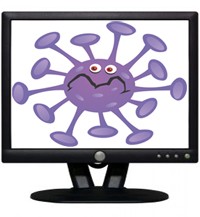25 Million New Malware Strains Identified in 2009

Security reports reveal that more than 25 million new strains of malware were identified in 2009 and was collectively the most in 20 years. Sixty-six percent of the new malware identified were banking Trojans, and the next popular type was scareware, also known as rogue anti-virus software that encourages web users to part with their hard-earned cash to download hoax security software that serves no purpose.
It has been predicted that the amount of malware in circulation will continue to grow to astronomical amounts during 2010 continuing on the same path as the year 2009.
Botnets ruled the cyber security landscape in 2009, with the 10 major heavyweight spam-sending botnets, including Cutwail, Rustock and Mega-D, now controlling at least 5 million compromised computers. With these compromised computers issuing over 83 percent of the 107 billion spam messages distributed globally, we can expect botnets to get bigger, stronger and more intelligent in 2010.
Windows 7, the newest and one of the most anticipated computer operating systems, will surely attract the interest of hackers when it comes to designing new malware. Not only will PCs be a prime target this year but also attacks on the Mac OS will increase. While we are likely to witness more politically motivated attacks security reports conclude that, once again, this will not be the year of the mobile phone virus, experts say.
Did you know that 92 percent of all emails sent in 2009 were classified as spam and social networks such as Facebook and Twitter became popular with cybercriminals as a major distribution channel for malware? The popularity of social networking and micro-blogging sites has also led spammers to use short URLs in their spam emails. In 2009, over 90 percent of spam contained a URL and there was an upsurge of short URLs in the 2nd half of the year. Short URLs hide the true website behind the link, yet are trusted by millions of people who use them to share photos and news online. New social technologies will lead to even more creativity on behalf of the bad guys.
CAPTCHA breaking tools, or automated apps designed to bypass CAPTCHA security verification pages, have allowed cybercriminals access an unprecedented number of webmail, IM and social networking websites. But, with a new crop of more sophisticated CAPTCHAs on the horizon, some involving images and animation, it will be increasingly difficult for hackers to solve these puzzles with an automatic computer program.
Automated translation services allow cybercriminals to target their attacks in local languages. While over 95 percent of spam is in English, there's been significant increases in spam in countries where English was not the primary language last year. After English, the most common languages for spam (in order) are French, Portuguese, Russian and German. Spam levels in Germany and The Netherlands alone increased by 13 percent since the beginning of 2009.
World events, news, and holidays always spark a bad guy's imagination when it comes to cybercriminal activity. In 2009, spammers and malware writers jumped on the news of the H1N1 virus and the death of Michael Jackson. So expect to see more popular news stories and celebrity names in your junk folder this year!
What have you done to prevent from becoming a victim of cybercrime? Do you use an anti-virus or anti-spyware application to keep you safe from attacks over the internet or do you use "safe surfing" practices in hopes that you can dodge the hacker-bullet in 2010?